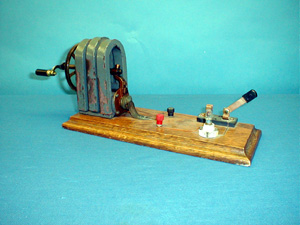Demos: 6B-09 Magneto (Electric Generator)

A hand cranked electrical generator is connected to a load, the latter consisting of an electric light bulb whose brightness depends on the speed at which the generator is cranked.
Directions: With the light bulb screwed in, turn the crank of the generator at such a speed as to produce light in the bulb. Then by turning the crank faster, show that the brightness increases.
Suggestions for Presentation: After discussing the concept of a generator, explain the setup involving this apparatus. The coil is turned in a stationary magnetic field set up by the horseshoe magnets. Explain that the brightness of the bulb is directly related to the voltage across the bulb’s terminals. Relate this to Faraday’s Law about the voltage being related to the rate of change of flux. Although the students can’t tell from a visual perspective, you might point out that you easily tell the difference when the bulb is in the circuit and when it isn’t. (The crank is more difficult to turn when the load is in the circuit. Relate this to why your car uses more gasoline when the load in the alternator circuit increases, as when the lights are on and/or the air conditioner is running.)
For a little humor, suggest that the reason electric rates are so high is the need for lots of people to turn those cranks to generate electricity!!!
Also available and highly recommended: A pair of commercial hand-cranked generators is available to show the connection between a generator and a motor. Connect the generators to each other by the alligator clips. Make sure the handle of the second one is free to turn. Crank the handle of the first generator and watch the other’s handle turn. It is essentially a motor being driven by a generator. Now pick up the second one and repeat the demo. The same thing occurs. This shows that a motor and a generator are conceptually the same thing.
Applications: Electrical energy generation.
Last Updated: Nov 30, 2023 11:25 AM